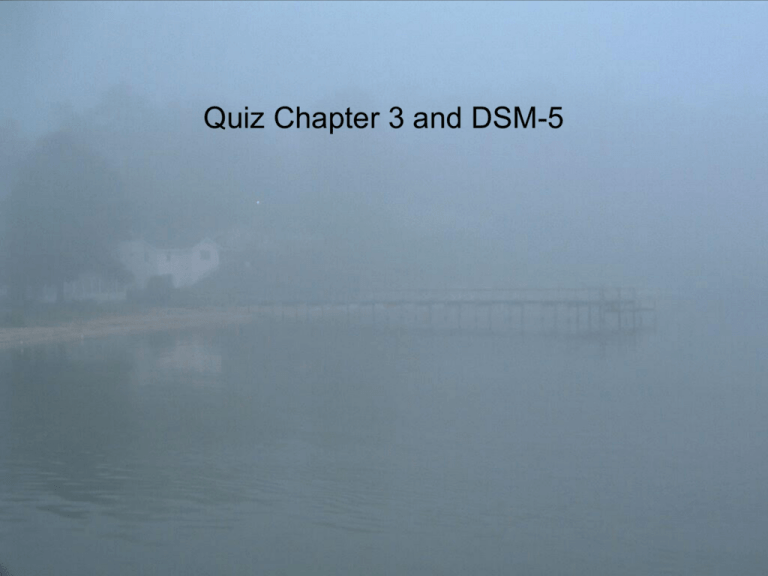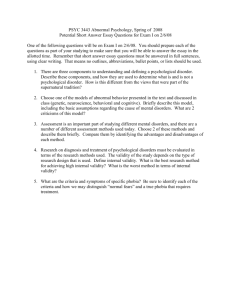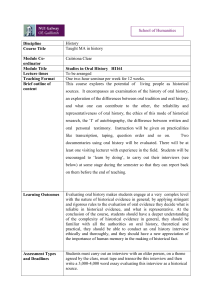Quiz 3
advertisement

Quiz Chapter 3 and DSM-5 1. Without _____, most psychological tests are meaningless. (p. 69) • • • • • a. the MMPI-2 b. interview data c. structure d. DSM-5 e. construct validity 1. Without _____, most psychological tests are meaningless. (p. 69) • • • • • a. the MMPI-2 b. interview data c. structure d. DSM-5 e. construct validity 2. Two of the most defining features of psychology in the 1990’s were managed care and the controversy of the validity of A. B. C. D. E. psychological tests the DSM-5 projective tests drug treatment for depression repressed memories 2. Two of the most defining features of psychology in the 1990’s were managed care and the controversy of the validity of A. B. C. D. E. psychological tests the DSM-5 projective tests drug treatment for depression repressed memories 3. _____ result (s) from the tendency of an interviewer to develop a general impression of a person and then infer other seemingly related characteristics. A. B. C. D. E. Cognitive dissonance Racial Bias Psychological Reactance Ambulatory sensors Halo Effects 3. _____ result (s) from the tendency of an interviewer to develop a general impression of a person and then infer other seemingly related characteristics. A. B. C. D. E. Cognitive dissonance Racial Bias Psychological Reactance Ambulatory sensors Halo Effects 4. The goal of a diagnostic interview is to A. make the client feel uncomfortable B. discuss unpleasant facts and feelings in order to develop rapport C. develop a specific diagnosis D. ask questions which lead to defensiveness E. be direct if time is limited 4. The goal of a diagnostic interview is to A. make the client feel uncomfortable B. discuss unpleasant facts and feelings in order to develop rapport C. develop a specific diagnosis D. ask questions which lead to defensiveness E. be direct if time is limited 5. According to the check list for an assessment interview and case history, ____ belongs in family background. A. B. C. D. E. adjustment to school recurring dreams socio-economic level earliest memory Events that create happiness 5. According to the check list for an assessment interview and case history, ____ belongs in family background. A. B. C. D. E. adjustment to school recurring dreams socio-economic level earliest memory Events that create happiness 6. Increased structure may undermine one of the greatest strengths of interviews: A. B. C. D. E. reliability validity Flexibility Structure conviviality 6. Increased structure may undermine one of the greatest strengths of interviews: A. B. C. D. E. reliability validity Flexibility Structure conviviality 7. The official coding system in use in the United States as of publication of the DSM-5 is the: A. B. C. D. E. Health Codes for Dummies Nomenclature Prevention Plus III system National Nomenclature Nosology Height Report International Classification of Diseases 7. The official coding system in use in the United States as of publication of the DSM-5-TR is the: A. B. C. D. E. Health Codes for Dummies Nomenclature Prevention Plus III system National Nomenclature Nosology Height Report International Classification of Diseases 8. Clustering disorders according to internalizing and externalizing factors has empirical support. An example of internalizing is: A. B. C. D. Anxiety symptoms Impulsive behavior Disruptive conduct Substance Use 8. Clustering disorders according to internalizing and externalizing factors has empirical support. An example of internalizing is: A. B. C. D. Anxiety symptoms Impulsive behavior Disruptive conduct Substance Use 9. _____ define mutually exclusive and jointly exhaustive phenomenological subgroups. A. B. C. D. E. specifiers species subtypes syndromes NOS 9. _____ define mutually exclusive and jointly exhaustive phenomenological subgroups. A. B. C. D. E. specifiers species subtypes syndromes NOS 10. In terms of nomenclature, sex differences are: A. B. C. D. E. Related to one’s perceived gender Those having to do with self-representation Attributable to reproductive organs Based on XX or XY chromsomal complement C&D THE END 10. In terms of nomenclature, sex differences are: A. B. C. D. E. Related to one’s perceived gender Those having to do with self-representation Attributable to reproductive organs Based on XX or XY chromsomal complement C&D







